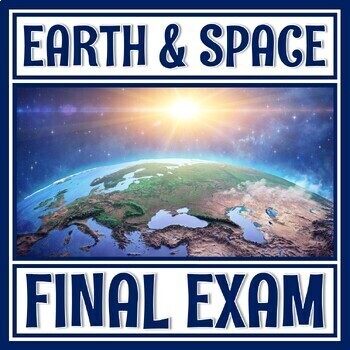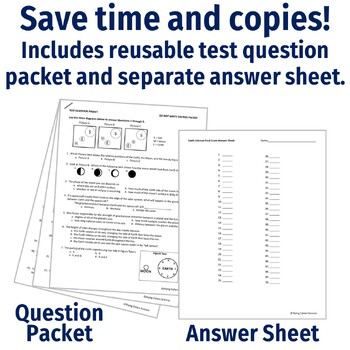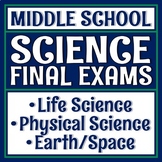Middle School Earth Science FINAL EXAM ASSESSMENT for NGSS MS-ESS
- PDF
What educators are saying
Also included in
- SAVE MORE THAN 25% with this set of 9 middle school Earth and space science tests for every unit of the year!⭐ YOUR WORK IS DONE! This an entire year of summative assessments designed for 6th, 7th, and 8th-grade NGSS-aligned Earth and space science classes.⭐ Get kids THINKING! The tests in this collPrice $26.99Original Price $36.91Save $9.92
- SAVE MORE THAN 25%! This bundle contains every NGSS-based Earth and Space Science quiz and test offered by Flying Colors Science. Get kids THINKING! Each assessment reflects the intended rigor of the Next Generation Science Standards by including questions that are much more than "definition styPrice $49.99Original Price $78.15Save $28.16
- Never search for "something to do tomorrow" ever again! This bundle contains PRINT AND GO lessons, NO PREP activities, LOW PREP labs, and ENGAGING articles to supplement and thoroughly enhance an Earth and space science course. Every included resource is easy to implement, standards-based, and high-Price $399.99Original Price $639.06Save $239.07
- BUY 2 GET 1 FREE! Includes 3 FINAL EXAMS for middle school science!Tests Included in Bundled Set:Life Science Final Exam (40 Questions, 2 versions)Physical Science Final Exam (50 Questions, 2 versions)Earth and Space Science Final Exam (50 Questions, 1 version)Each included test focuses on the essenPrice $9.99Original Price $14.97Save $4.98
Description
50 Multiple Choice Question Test - mimics standardized tests! Also can be used as a pre-assessment.
⭐ Get this resource at a discount in our NGSS Science Final Exam Set.
Topics Include:
- Moon phases/eclipses
- Tides
- Scale of objects in the solar system
- Gravity in the solar system
- Earth's motions in space
- Weathering and erosion
- Rock cycle
- Plate tectonics
- Weather and climate
NGSS Standards Covered: MS-ESS1-1, MS-ESS1-2, MS-ESS1-3, MS-ESS1-4, MS-ESS2-1, MS-ESS2-2, MS-ESS2-3, MS-ESS2-4, MS-ESS2-5
This final and cumulative test assesses the essential understandings of middle school NGSS Earth and space science topics. Some questions include simple diagrams to analyze and mimic the way NGSS-based standardized tests generally ask about these topics. There are 50 questions.
Less copies and easy to correct - save time with our test packet format! This version of the test is designed to have a test question packet (3 pages front/back) and a separate answer sheet (1 page). You only need to make one class set of copies of the test question packet because it can be reused class-to-class. Students ONLY write on their provided answer sheet.
Teacher Notes:
- Find the self-correcting GOOGLE FORMS VERSION of this test HERE.
- ANSWER KEY PROVIDED.
- Please note that this resource is not editable.
We also offer:
NGSS Physical Science FINAL EXAM
⭐⭐⭐ Click here to get 5 FREE EARTH & SPACE SCIENCE lessons! ⭐⭐⭐









